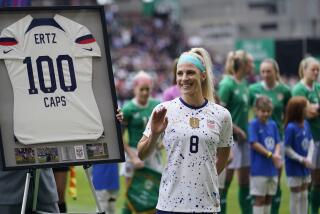Capriati Is More Than Two-Handed Backhand
- Share via
NEW YORK — This is what Chris Evert leaves behind, like trees she planted and watched take root and grow: Her style (two-fisted and ladylike), which led to big numbers (unprecedented prize money and endorsement dollars), which led to other big numbers (a boom in little-girl participation), which led to massive parental involvement (not all of it good).
And, she leaves behind 13-year-old Jennifer Capriati of Saddlebrook, Fla., the most talked-about junior player at the U.S. Open.
Capriati is specifically meant to be the next Chris Evert. Capriati’s first official coach was Evert’s father, Jimmy. Capriati first hit tennis balls with Evert when Capriati was 9. Capriati is now advised in business matters by Evert’s brother, John. And last Christmas, Capriati was given a 14-karat gold bracelet by Evert. It says “Jennifer” on the outside, and “Love, Chris” on the inside.
But, in general, Evert’s tennis legacy is much bigger than a single little girl, standing on a long line to be the next Queen of Tennis. That long line is part of the legacy.
All those two-fisted backhanders. “I certainly never saw many two-fisted backhanders when Jimmy and I were first married,” said Evert’s mother, Colette. Jimmy wanted Evert to hit her backhand with one hand, but she kept sneaking practice with two, and at last it dawned on him that “little girls just aren’t strong enough to hit it one-handed.” Since the beginning of Evert’s career dovetailed with televised open tennis, she had the visibility to make the two-hander an international craze.
Men used, and boys copied, the two-handed backhand, too; Jimmy Connors and Bjorn Borg hit that way. But the difference for women -- girls, really -- was that they to use it when they first started playing, said Tommy Thompson, head pro of the Harry Hopman Tennis Academy in Florida, “or they couldn’t generate the power to hit the shot. Then, once they got used to it, they didn’t want to change when they got older and stronger.”
Besides, Evert had proved that there was no need to change. And, meanwhile, in so many cases, young girls were being worn out (mentally or physically) by the endless workload of playing this baseline, two-handed backhand game developed so young. “With the girls,” Thompson said, “since they’re much smaller than boys, every single point is a grind. They put everything they have behind the ball just to hit it as hard as they do, and they play that groundstroke game.”
Plus, there always has been the matter of being realistic. Parents put oversized rackets in the hands and oversized expectations in the heads of a child giving an early glimpse of talent; “outside interference” is the most feared predator of young players’ careers, Thompson said. “If you’ve ever watched junior tournaments, you’d know,” said Colette Evert, whose five children all won national junior titles. “You get parents all the time who’ll come up to you after a match and say, ‘I’m so glad my son beat your son.’ It’s like a knife.”
“It’s intense,” said top-ranked girls junior Jo-Anne Faull. “It’s scary, in a way.” When Faull, 18 now, was growing up in the Australian Outback, she played tennis for fun and used a one-handed backhand. When her family moved to the city, when she was 11, a coach immediately taught her the two-fisted backhand. Coaches were looking for new Everts, too.
Jimmy Evert wonders, if his daughter were only 13 now, whether he might fear a bit for Chris becoming a professional tennis player. He didn’t then. “I’m telling you, when Chris was 13, 14,” he said, “she’d go play with her friend Laurie Fleming, and half the time they were out there they were talking.” It was fun, social.
It’s different now for Capriati, who looks at Evert with admiration and says, “The way she is on the court, so ladylike. She’s my idol.”
More to Read
Go beyond the scoreboard
Get the latest on L.A.'s teams in the daily Sports Report newsletter.
You may occasionally receive promotional content from the Los Angeles Times.










